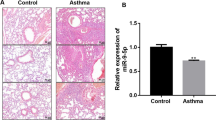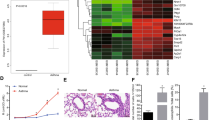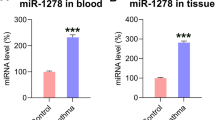Abstract
We aimed to investigate the effect of miR-506-3p on the proliferation and apoptosis of airway smooth muscle cells (ASMCS) in asthmatic mice by regulating the activation of TLR4/NF-κB signaling pathway through targeted regulation of C–C Motif Chemokine Ligand 2 (CCL2) expression. Twenty-four BALB/c mice of specific pathogen-free grade were selected to establish asthmatic mouse model, which were randomly divided into normal control group and asthma model group (n = 12 for each group). HE and IHC staining, bioinformatics and dual luciferase reporter assay, RT-PCR MTT, flow cytometry and Western blot were used in this research. HE staining showed airway epithelium thickening, submucosal inflammatory cell infiltration and airway smooth muscle thickening, and the positive expression rate of CCL2 was significantly increased in asthma model group (all P < 0.05). CCL2 was the target gene of miR-506-3p. Moreover, the expression of miR-506-3p in asthma model group was significantly decreased, the mRNA and protein expression levels of CCL2, TLR4, NF-κB (p65) and Bcl-2 were significantly increased, while those of Bax were decreased (all P < 0.05). In miR-506-3p mimic group or siRNA-CCL2 group, the expression of CCL2, TLR4, NF-κB (p65) and Bcl-2 decreased obviously, while that of Bax increased, cell proliferation decreased, G1 phase prolonged, G2 & S phases shortened, and apoptosis rate increased significantly (all P < 0.05), whereas the opposite trends were found in miR-506-3p inhibitor group (all P < 0.05). However, there was no statistical difference in the above-mentioned indexes in miR-506-3p inhibitor + siRNA-CCL2 group (all P > 0.05). Overexpression of miR-506-3p can inhibit ASMCS proliferation and promote apoptosis via inhibiting CCL2 expression and suppressing the activation of TLR4/NF-κB signaling pathway. Inhibited expression of miR-506-3p can reverse the positive role of CCL2 gene silencing. Our study is the first to prove the beneficial role of miR-506-3p-CCL2-TLR4/NF-κB regulatory axis in the development of asthma.









Similar content being viewed by others
References
Nastaravičius, A., & Ramanauskienė, K. (2018). Role of a community pharmacy service in care of bronchial asthma patients in Lithuania. Canadian Respiratory Journal, 2018, 6060581.
Domingo, C., Moreno, A., & Mirapeix, R. (2011). Rationale for the use of immunomodulatory therapies in the Global Initiative for Asthma (GINA) step V asthma other than oral glucocorticosteroids. Internal Medicine Journal, 41(7), 525–536.
Kukreja, S. (2017). A comprehensive study on the applications of artificial intelligence for the medical diagnosis and prognosis of asthma. SSRN Electronic Journal. https://doi.org/10.2139/ssrn.3081746
Agusti, A., Bel, E., Thomas, M., Vogelmeier, C., Brusselle, G., Holgate, S., Humbert, M., Jones, P., Gibson, P. G., Vestbo, J., Beasley, R., & Pavord, I. D. (2016). Treatable traits: Toward precision medicine of chronic airway diseases. European Respiratory Journal, 47(2), 410–419.
Ito, T., Hirose, K., & Nakajima, H. (2019). Bidirectional roles of IL-22 in the pathogenesis of allergic airway inflammation. Allergology International, 68(1), 4–8.
Goodman, H. S. (2014). The role of pathogen associated molecular patterns in the pathogenesis of asthma. Journal of University of Aberdeen, 12, 37–39.
Ling, K. M., Sutanto, E. N., Iosifidis, T., et al. (2016). Reduced transforming growth factor β1 (TGF-β1) in the repair of airway epithelial cells of children with asthma. Respirology, 21(7), 1219–1226.
Chuanjun, H., Yonglian, Z. H., Yanqi, D., et al. (2017). Intervention of combination of asarone and budesonide on airway remodeling and expression of inflammatory factors in asthmatic mice. Chinese Journal of Clinicians, 23, 65–68.
Yang, Q. (2017). Effect of anxiety and depression on pulmonary function as well as airway inflammation and remodeling in patients with bronchial asthma. Journal of Hainan Medical University: English Edition, 023(017), 29–32.
Rhee, C. K., Kim, J. W., Park, C. K., et al. (2011). Effect of imatinib on airway smooth muscle thickening in a murine model of chronic asthma. International Archives of Allergy and Immunology, 155(3), 243–251.
Lin, T. Y., Venkatesan, N., Nishioka, M., Kyoh, S., Al-Alwan, L., Baglole, C. J., Eidelman, D. H., Ludwig, M. S., & Hamid, Q. (2014). Monocyte-derived fibrocytes induce an inflammatory phenotype in airway smooth muscle cells. Clinical and Experimental Allergy, 44(11), 1347–1360.
Gu, M. X., Liu, X. C., & Jiang, L. (2013). Effect of peroxisome proliferator-activated receptor-gamma on proliferation of airway smooth muscle cells in mice with asthma. Chinese Journal of Contemporary Pediatrics, 15(7), 583–587.
James, S. Y., Mackay, A. G., & Colston, K. W. (1996). Effects of 1,25 dihydroxyvitamin D3 and its analogues on induction of apoptosis in breast cancer cells. Journal of Steroid Biochemistry and Molecular Biology, 58(4), 395–401.
Park, S. J., & Lee, Y. C. (2010). Interleukin-17 regulation: An attractive therapeutic approach for asthma. Respiratory Research, 11(1), 78.
Lin, X., Yang, C., Huang, L., Chen, M., Shi, J., Ouyang, L., Tang, T., Zhang, W., Li, Y., Liang, R., & Jiang, S. (2016). Upregulation of TRPM7 augments cell proliferation and interleukin-8 release in airway smooth muscle cells of rats exposed to cigarette smoke. Molecular Medicine Reports, 13(6), 4995–5004.
Gough, K. C., Maddison, B. C., Shikotra, A., Moiseeva, E. P., Yang, W., Jarvis, S., & Bradding, P. (2015). Evidence for a novel Kit adhesion domain mediating human mast cell adhesion to structural airway cells. Respiratory Research, 16(1), 86.
Liang, X., Wang, J., Chen, W., Ma, X., Wang, Y., Nagao, N., Weng, W., Huang, J., & Liu, J. (2017). Inhibition of airway remodeling and inflammation by isoforskolin in PDGF-induced rat ASMCs and OVA-induced rat asthma model. Biomedicine & Pharmacotherapy, 95, 275–286.
Wang, J., Shang, Y. X., Cai, X. X., & Liu, L. Y. (2018). Vasoactive intestinal peptide inhibits airway smooth muscle cell proliferation in a mouse model of asthma via the ERK1/2 signaling pathway. Experimental Cell Research, 364(2), 168–174.
Li, R., Wang, J., Li, R., et al. (2018). ATP/P2X7-NLRP3 axis of dendritic cells participates in the regulation of airway inflammation and hyper-responsiveness in asthma by mediating HMGB1 expression and secretion. Experimental Cell Research, 366, 1–15.
Sakai, H., Suto, W., Kai, Y., et al. (2017). Mechanisms underlying the pathogenesis of hyper-contractility of bronchial smooth muscle in allergic asthma. Journal of Smooth Muscle Research, 53, 37–47.
Pei, Q. M., Jiang, P., Yang, M., et al. (2016). Upregulation of a disintegrin and metalloproteinase-33 by VEGF in human airway smooth muscle cells: Implications for asthma. Cell Cycle, 15, 2819–2826.
Zhang, H., Zhang, D., Li, H., Yan, H., Zhang, Z., Zhou, C., Chen, Q., Ye, Z., & Hang, C. (2018). Biphasic activation of nuclear factor-κB and expression of p65 and c-Rel following traumatic neuronal injury. International Journal of Molecular Medicine, 41(6), 3203–3210.
Yu, Z.-S., Li, P.-C., Yao, L., et al. (2016). Research progress on intervention of traditional Chinese medicine on coronary heart disease through NF-κB signal transduction pathway. Chinese Traditional Herbal Drugs, 2016, 67–69.
Hwang, K. A., Hwang, Y. J., & Song, J. (2018). Aster yomena extract ameliorates pro-inflammatory immune response by suppressing NF-κB activation in RAW 264.7 cells. The Journal of the Chinese Medical Association, 81(2), 102–110.
Gagliardo, R., Chanez, P., Profita, M., et al. (2011). IκB kinase-driven nuclear factor-κB activation in patients with asthma and chronic obstructive pulmonary disease. The Journal of Allergy and Clinical Immunology, 128(3), 635–645.e2.
Xiao, M., Zhu, T., Wang, T., & Wen, F. Q. (2013). Hydrogen-rich saline reduces airway remodeling via inactivation of NF-κB in a murine model of asthma. European Review for Medical and Pharmacological Sciences, 17(8), 1033–1043.
Chen, Y., Liu, T., Langford, P., Hua, K., Zhou, S., Zhai, Y., Xiao, H., Luo, R., Bi, D., Jin, H., & Zhou, R. (2015). Haemophilus parasuis induces activation of NF-κB and MAP kinase signaling pathways mediated by toll-like receptors. Molecular Immunology, 65(2), 360–366.
Elovitz, M. A., Brown, A. G., Anton, L., Gilstrop, M., Heiser, L., & Bastek, J. (2014). Distinct cervical microRNA profiles are present in women destined to have a preterm birth. American Journal of Obstetrics and Gynecology, 210(3), 221.e1–221.e11.
Jazbutyte, V., & Thum, T. (2010). MicroRNA-21: from cancer to cardiovascular disease. Current Drug Targets, 11(8), 926–935.
Rudnicki, M., Perco, P., D’haene, B., et al. (2016). Renal microRNA- and RNA-profiles in progressive chronic kidney disease. European Journal of Clinical Investigation, 46(3), 213–226.
Zhenhao, L. I., Guangxian, X. U., Qian, G., et al. (2017). Target regulation of miR-506-3p on PIK3CA gene expression. Journal of Ningxia Medical University, 21, 23–27.
Jiang, X., Xiao, T. W., Lu, H. L., et al. (2019). Mechanism of mirna-506-3p regulating uhrf1 inhibiting colorectal cancer cell metastasis. Journal of Tongji University (Medical Edition), 040(003), 298–304.
Yang, H., Su, Y. J., Zhong, J. H., et al. (2019). Mir-506-3p targeted TRAF6 inhibits inflammatory response and cardiomyocyte apoptosis in myocarditis. Chinese Journal of Gerontology, 19, 45–48.
Khiati, A., Chaloin, O., Muller, S., et al. (2010). Induction of monocyte chemoattractant protein-1 (MCP-1/CCL2) gene expression by human immunodeficiency virus-1 Tat in human astrocytes is CDK9 dependent. Journal of Neurovirology, 16(2), 150–167.
Rafei, M., & Galipeau, J. (2010). A CCL2-based fusokine as a novel biopharmaceutical for the treatment of CCR2-driven autoimmune diseases. Critical Reviews in Immunology, 30(5), 449–461.
O’Connor, T., Borsig, L., & Heikenwalder, M. (2015). CCL2-CCR2 signaling in disease pathogenesis. Endocrine, Metabolic & Immune Disorders: Drug Targets, 15(2), 105–118.
Patel, J. K., Clifford, R. L., Deacon, K., et al. (2012). Ciclesonide inhibits TNFα- and IL-1β-induced monocyte chemotactic protein-1 (MCP-1/CCL2) secretion from human airway smooth muscle cells. American Journal of Physiology. Lung Cellular and Molecular Physiology, 302(8), L785–L792.
Ilges, D. T., Zhou, L. I., Hall, C., et al. (2018). KIT inhibition by imatinib in patients with severe refractory asthma—Impact on airway remodeling measured by MDCT. Journal of Allergy and Clinical Immunology, 141(2), AB11.
Yu, X., Zhe, Z., Tang, B., Li, S., Tang, L., Wu, Y., Chen, X., & Fang, H. (2017). α-Asarone suppresses the proliferation and migration of ASMCs through targeting the lncRNA-PVT1/miR-203a/E2F3 signal pathway in RSV-infected rats. Acta Biochimica et Biophysica Sinica (Shanghai), 49(7), 598–608.
Franceschelli, S., Pesce, M., Ferrone, A., et al. (2017). Biological effect of licochalcone C on the regulation of PI3K/Akt/eNOS and NF-κB/iNOS/NO signaling pathways in H9c2 cells in response to LPS stimulation. International Journal of Molecular Sciences, 18(4), 690.
Tulli, L., Cattaneo, F., Vinot, J., Baldari, C. T., & D’Oro, U. (2018). Src family kinases regulate interferon regulatory factor 1 K63 ubiquitination following activation by TLR7/8 vaccine adjuvant in human monocytes and B cells. Frontiers in Immunology, 9, 330.
Dalvi, P., Sun, B., Tang, N., & Pulliam, L. (2017). Immune activated monocyte exosomes alter microRNAs in brain endothelial cells and initiate an inflammatory response through the TLR4/MyD88 pathway. Scientific Reports, 7(1), 9954.
Jia, T., Fu, H., Sun, J., Zhang, Y., Yang, W., & Li, Y. (2012). Foxp3 expression in A549 cells is regulated by Toll-like receptor 4 through nuclear factor-κB. Molecular Medicine Reports, 6(1), 167–172.
Zhang, D., Bi, X., Liu, Y., et al. (2017). High phosphate-induced calcification of vascular smooth muscle cells is associated with the TLR4/NF-κb signaling pathway. Kidney and Blood Pressure Research, 42, 1205–1215.
Qiao, J. Y., Song, L., Zhang, Y. L., et al. (2017). HMGB1/TLR4/NF-κB signaling pathway and role of vitamin D in asthmatic mice. The Chinese Journal of Contemporary Pediatrics, 19(1), 95.
Slattery, M. L., Herrick, J. S., Mullany, L. E., et al. (2015). An evaluation and replication of miRNAs with disease stage and colorectal cancer-specific mortality. International Journal of Cancer, 137(2), 428–438.
Chapman, C. G., & Pekow, J. (2015). The emerging role of miRNAs in inflammatory bowel disease: A review. Therapeutic Advances in Gastroenterology, 8(1), 4–22.
Wang, J., Li, H. Y., Wang, H. S., & Su, Z. B. (2018). MicroRNA-485 modulates the TGF-β/Smads signaling pathway in chronic asthmatic mice by targeting Smurf2. Cellular Physiology and Biochemistry, 51(2), 692–710.
Zhang, X. Y., Tang, X. Y., Li, N., Zhao, L. M., Guo, Y. L., Li, X. S., Tian, C. J., Cheng, D. J., Chen, Z. C., & Zhang, L. X. (2018). GAS5 promotes airway smooth muscle cell proliferation in asthma via controlling miR-10a/BDNF signaling pathway. Life Sciences, 212, 93–101.
Funding
No.
Author information
Authors and Affiliations
Contributions
WM and QH designed and drafted the experiment research, analyzed the results and wrote the manuscript. All authors revised the manuscript and agreed to be accountable for all aspects of the presented work.
Corresponding author
Ethics declarations
Conflict of interest
The authors declare that they have no conflict of interest.
Additional information
Publisher's Note
Springer Nature remains neutral with regard to jurisdictional claims in published maps and institutional affiliations.
Supplementary Information
Below is the link to the electronic supplementary material.
Rights and permissions
About this article
Cite this article
Manli, W., Hua, Q. Effect of miR-506-3p on Proliferation and Apoptosis of Airway Smooth Muscle Cells in Asthmatic Mice by Regulating CCL2 Gene Expression and Mediating TLR4/NF-κB Signaling Pathway Activation. Mol Biotechnol 63, 410–423 (2021). https://doi.org/10.1007/s12033-021-00309-8
Received:
Accepted:
Published:
Issue Date:
DOI: https://doi.org/10.1007/s12033-021-00309-8




